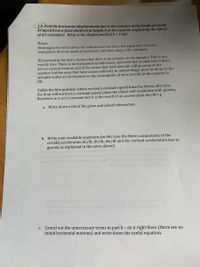Question
I could really use some help with part b, and c here.

Transcribed Image Text:1.8. Find the horizontal displacement due to the rotation of the Earth of a body
dropped from a fixed platform at height h at the equator, neglecting the effects
.of air resistance. What is the displacement if h = 5 km?
Notes:
Once again we write down the information we have, the equations we have,
manipulate them as much as necessary and then plug in the numbers.
We learned in the intro classes that there is no coriolis on the equator. This is not
exactly true. There is no horizontal coriolis force, and even that is only true if there
are no vertical motions (all of the terms that have sine phi will go away at the
equator, but the ones that have cosine will not). In meteorology, most motions in the
synoptic scales are horizontal, so the assumption of zero coriolis at the equator is
OK.
Unlike the first problem where we had a constant speed from the throw, this time
the drop will not have a constant speed (since the object will accelerate with gravity,
therefore, w is not a constant but it is the result of an acceleration dw/dt=-g
a. Write down a list of the given and asked information.
b. Write your available equations (in this case the three components of the
coriolis acceleration du/dt, dv/dt, dw/dt and the vertical acceleration due to
gravity as explained in the notes above)
bean rovew
hnex
06 diw qu bs bluode noY
tonla moldorg odi lo bno od ton
L NOW substtiute your
displaceent isshisan
The answerls -7.7m)
C. Cancel out the unnecessary terms in part b – do it right there (there are no
initial horizontal motions) and write down the useful equation.
Expert Solution
This question has been solved!
Explore an expertly crafted, step-by-step solution for a thorough understanding of key concepts.
This is a popular solution
Trending nowThis is a popular solution!
Step by stepSolved in 4 steps

Knowledge Booster
Similar questions
- NOTE: Parts A and Part B and Part C are already included. I need help with Part D. That is why I included Parts A, B, and C. What is the solution to Part D?arrow_forwardHi! I only need help with Part 1 of 3. You can ignore the tutorial questions at the top.arrow_forwardPretty sure my answer in the blank is wrong, so just ignore thatarrow_forward
- This is for my astronomy class. I don't even know where to start: using the relationship “force equals mass times acceleration,” write an answer the following question: if an object with mass X grams is being accelerated at Z centimeters per second squared, then how much force is being exerted on the object? Show your calculations.arrow_forwardHello, I'd like some help for part c, thanksarrow_forwardCan I please get help for part C in the first picture, and all of second picture. Please and thank you!arrow_forward
- Help! I know that Part 2 is correct. I need to be sure that Part 1 is correct and need an answer and breakdown of Part 3!arrow_forwardHello, I really truly need help with part A,Part B and Part C I don't know why I keep getting the wrong answer and my professor won't help. Can you please please please help me with Part A,Part B and Part C because I don't how to do it and can you label it as well. Thank you so so mucharrow_forwardHello, I am really confused with this homework I was hoping you can help me with part A, PART B AND PART C. I have done all of the parts three times and I am still getting the wrong answer, I was hoping if you can help me with part A, PART B AND PART C and also can you label which one is which please so I can know which one is which.arrow_forward
- I'm confused of what part A isarrow_forwardThe second sentence in step 2 doesn't make sense please can you review?arrow_forwardResume Bui X Action Cent X Can't Buy Ti X Biology Bac X Bb My Grades x Schedules o X https://www X A University a x b My Questio x + docs.google.com/document/d/1pQhEBaWXYWxTk327EPalSjdDio91Zaf8RIghg92dlXw/edit?pli=1 Paused Update : Can't Buy Time * A @ Saved to Drive Share File Edit View Insert Format Tools Add-ons Help Last edit was seconds ago + ΒΙυ A. E 1E 100% Normal text Verdana 14 Editing 31 1 1 | 3 6 5. The width of a slit is 2.0 x 10-5 m. Light with a wavelength of 540 nm passes through this slit and falls on a screen that is located 0.70 m away. In the diffraction pattern, find the width of the bright fringe that is next to the central bright fringe. Second dark fringe Bright fringe First dark fringe Central bright fringe First dark fringe Bright fringe Second dark fringe Single slit Screen > 4:39 PM O Type here to search 后 4/30/2021 !!! II lıli 近arrow_forward
arrow_back_ios
SEE MORE QUESTIONS
arrow_forward_ios